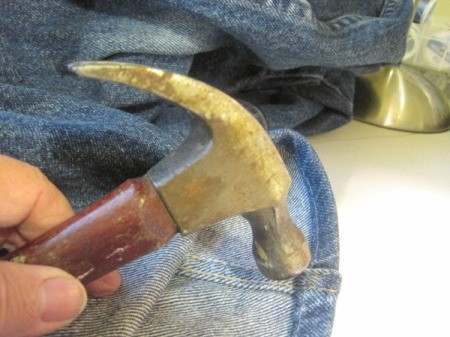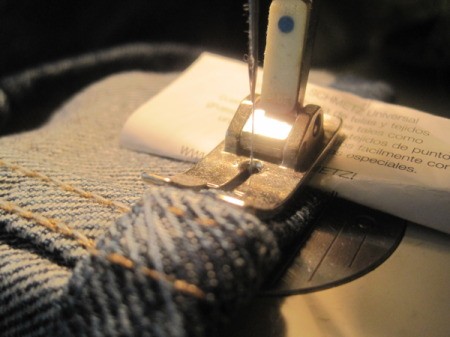I have hemmed plenty of jeans in my time and broken a lot of needles. The following are tips to do it and save your needles. First of all, look for needles that are made specifically for hemming jeans.

Secondly after you have pressed your double hem up, before you sew, take a hammer and pound the seam that is so thick (it is called a flat felled seam). I know this step sounds funny, but it works. As you are sewing along, when you come to a thick place and your presser foot won't allow you to go over it, insert a piece of cardboard about the thickness of two credit cards under the presser foot from the back. This allows you to "climb" the seam with ease. Lastly, sew very slowly and do not reverse. You are most likely to save needles using these hints.
By Elaine S. from Near Cedar Rapids, IA
When I hem heavy fabrics like that, I don't bother turning it under. Just zig zag the raw edge in place.
You can buy the foot for the sewing machine, called the jumper foot.
When hemming jeans, I cut the pants along the current finished hem, using hem lace, finish the edge and continue to fold so pants is the length, match up the jean color with thread color and finish straight stitch sewing at stitch length a bit longer than normal sewing but not gathering length.
This eliminates the thickness problem.
Another suggestion is to wash the jeans, let them soak in some fabric softner a bit (shut the washer off during the rinse cycle) and the softner softens up the denim as well.
I shorten/hem dress pants as well this way.
You can also cut off the existing bottom hem, leaving about a half inch of single fabric, and then sew it back on at the desired length after cutting the legs to where you want them, plus one half inch for seam allowance. Sew the original bottom hem back on, and this makes it look like the original stitching.
I sew using the older sewing machines and I just unscrew the tension at the top of the sewing machine that controls the pressure on the fabric and it works great! Now On the newer machines I don't know if they have the tension knob at the top of the sewing machine.